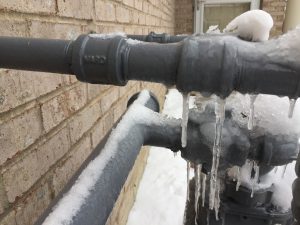Crucial Advice to Protect Against Frozen Plumbing in Winter
Crucial Advice to Protect Against Frozen Plumbing in Winter
Blog Article
Are you on the lookout for related information about Prevent Frozen Pipes ?

Winter can wreak havoc on your pipes, particularly by freezing pipes. Right here's just how to stop it from happening and what to do if it does.
Introduction
As temperatures drop, the danger of frozen pipes boosts, potentially bring about pricey repairs and water damages. Recognizing exactly how to avoid frozen pipes is crucial for homeowners in cool environments.
Prevention Tips
Shielding prone pipes
Cover pipes in insulation sleeves or make use of warm tape to protect them from freezing temperature levels. Concentrate on pipes in unheated or external areas of the home.
Home heating strategies
Keep indoor rooms adequately heated up, specifically areas with plumbing. Open closet doors to permit warm air to circulate around pipes under sinks.
Just how to recognize frozen pipes
Try to find decreased water circulation from taps, unusual odors or noises from pipes, and noticeable frost on exposed pipelines.
Long-Term Solutions
Structural modifications
Consider rerouting pipelines away from exterior wall surfaces or unheated locations. Include added insulation to attic rooms, basements, and crawl spaces.
Updating insulation
Buy top quality insulation for pipes, attics, and walls. Proper insulation helps maintain consistent temperature levels and lowers the threat of icy pipes.
Safeguarding Exterior Pipes
Garden tubes and outside faucets
Separate and drain pipes garden tubes before wintertime. Set up frost-proof spigots or cover outside faucets with insulated caps.
Recognizing Frozen Pipelines
What triggers pipelines to ice up?
Pipes ice up when revealed to temperature levels listed below 32 ° F (0 ° C) for expanded durations. As water inside the pipelines ices up, it expands, putting pressure on the pipe walls and potentially creating them to burst.
Dangers and problems
Icy pipelines can bring about supply of water interruptions, residential or commercial property damage, and expensive repair work. Ruptured pipelines can flood homes and cause extensive architectural damages.
Indications of Frozen Pipes
Recognizing icy pipes early can prevent them from bursting.
What to Do If Your Pipelines Freeze
Immediate activities to take
If you think frozen pipelines, keep taps open to soothe pressure as the ice thaws. Use a hairdryer or towels taken in hot water to thaw pipes slowly.
Verdict
Avoiding icy pipes needs proactive procedures and fast responses. By comprehending the causes, indicators, and preventive measures, property owners can protect their pipes throughout cold weather.
5 Ways to Prevent Frozen Pipes
Drain Outdoor Faucets and Disconnect Hoses
First, close the shut-off valve that controls the flow of water in the pipe to your outdoor faucet. Then, head outside to disconnect and drain your hose and open the outdoor faucet to allow the water to completely drain out of the line. Turn off the faucet when done. Finally, head back to the shut-off valve and drain the remaining water inside the pipe into a bucket or container. Additionally, if you have a home irrigation system, you should consider hiring an expert to clear the system of water each year.
Insulate Pipes
One of the best and most cost-effective methods for preventing frozen water pipes is to wrap your pipes with insulation. This is especially important for areas in your home that aren’t exposed to heat, such as an attic. We suggest using foam sleeves, which can typically be found at your local hardware store.
Keep Heat Running at 65
Your pipes are located inside your walls, and the temperature there is much colder than the rest of the house. To prevent your pipes from freezing, The Insurance Information Institute suggests that you keep your home heated to at least 65 degrees, even when traveling. You may want to invest in smart devices that can keep an eye on the temperature in your home while you’re away.
Leave Water Dripping
Moving water — even a small trickle — can prevent ice from forming inside your pipes. When freezing temps are imminent, start a drip of water from all faucets that serve exposed pipes. Leaving a few faucets running will also help relieve pressure inside the pipes and help prevent a rupture if the water inside freezes.
Open Cupboard Doors
Warm your kitchen and bathroom pipes by opening cupboards and vanities. You should also leave your interior doors ajar to help warm air circulate evenly throughout your home.

Do you appreciate more info about How To Avoid Freezing Pipes? Try leaving a review down the page. We would be pleased to hear your reactions about this review. In hopes that you come back again later on. Are you aware of somebody who is looking into the niche? Be sure share it. I cherish reading our article about Preventing and dealing with frozen pipes.
Estimate Free Report this page